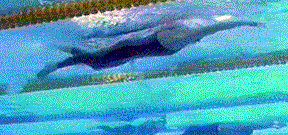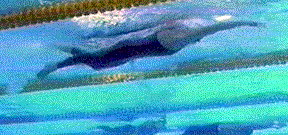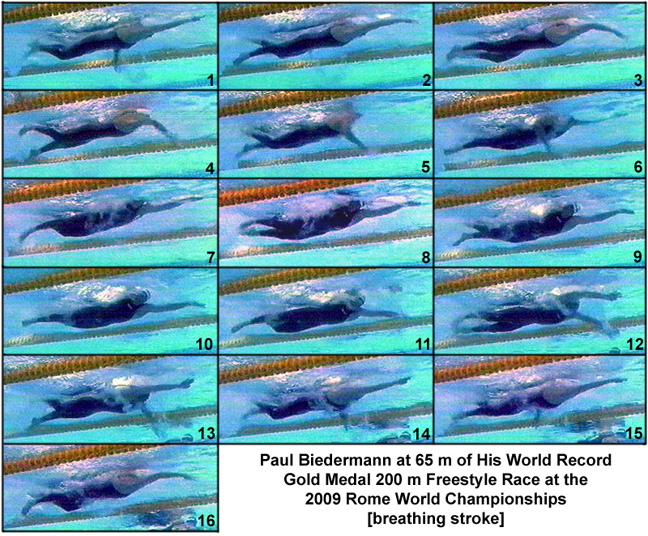HOW CHAMPIONS DO IT
Researched, produced, and prepared by Brent S. Rushall,
Ph.D., R.Psy.

PAUL BIEDERMANN AT 65 m OF HIS WORLD RECORD GOLD MEDAL 200 m FREESTYLE RACE AT THE 2009 ROME WORLD CHAMPIONSHIPS (breathing stroke)
Each frame of this analysis is 0.1 seconds apart. Paul Biedermann's time for this 200 m freestyle event was 1:42.08.
This stroke analysis includes a moving sequence in real time, a moving sequence where each frame is displayed for .5 of a second, and still frames.
The following image sequence is in real time. It will play through 10 times and then stop. To repeat the sequence, click the browser's "refresh" or "reload" button.

The following image sequence shows each frame for half a second. It will play through 10 times and then stop. To repeat the sequence, click the browser's "refresh" or "reload" button.

At the end of the following narrative, each frame is illustrated in detail in a sequential collage.
Notable Features
Much of Paul Biedermann's technique in this breathing stroke is similar but has notable differences to that of the non-breathing stroke. However, the duration of the inertial lag is increased by the added breathing action (Frames #7 through #13). As well, the head action appears to be a lift forward (Frame #5), a turn when emerging from or out of the water (Frame #6), and then an extended inhalation with head to the side (Frames #7 through #11). The return of the head into the water from the elevated position causes a large amount of turbulence to stream off the face for about three tenths of a second (Frames #10 through #13). When the head is finally returned into the water (Frame #13), the face turbulence breaks away and flows down the swimmer's front for the remainder of the stroke (Frames #13 through #16). It is this writer's opinion that the amount of turbulence developed through the head action would be equivalent to or more than that created by the surface of any swimsuit or an unshaven body. In other words, the amount of resistive turbulence created by the head action in breathing is considerable and worthy of attention to diminish or eliminate it.
- Frames #1 through #3: As the left arm completes it propulsive phase, the right arm is repositioned to begin effective stroking. The streamline of the swimmer's body remains noteworthy throughout the stroke.
- Frame # 4: The left leg has kicked to counterbalance the vertical force component created by the repositioning of the right arm. Propulsion has begun in this frame. Considerable abduction moves the upper arm rapidly.
- Frame #5: The head is raised. Perhaps the angled forearm in the previous frame that develops a notable vertical force component and the continued angled forearm in this frame provide the force to enable the head lift without any alteration in body alignment. The right leg has begun to kick to counterbalance the entry of the left arm and possibly add further to the force needed to support the elevated head.
- Frame #6: Adduction of the right arm is complete while the hand-forearm remains upright. The kick and entered left arm probably support the raised head and so the final push of the arm on the water is mainly horizontal.
- Frame #7: A rapid final vertical movement of the right arm commences the exit-recovery phase. The left arm pressing down and the dragging right leg provide forces to support the right-arm action but not enough to hold the head as high as in previous frames. The head is on its left side and lowered partially back into the water.
- Frame #8: The left leg kicks to support the rapid right-arm recovery's vertical force component. The left arm presses directly down as the head remains on its side. The shoulders and hips have rotated to an angle that gives the appearance of the swimmer being mostly on his left side. The head remains turned.
- Frame #9: The left arm is still forward and pressing down. The opportunity to create propulsive force with the left arm is being squandered as it is used to support an extended and excessive-movement breathing action as well as a rapid recovery. The right leg is raised high preparatory to kicking.
- Frame #10: The right-arm recovery is forward of the shoulders. The head begins to rotate back down. The left am continues to press down. The shoulders and body are turning away from the extreme rotation displayed in Frames #8 and #9. The right leg kicks.
- Frame #11: The right arm enters while the left arm continues to press down. This is an undesirable "overlapped-arm" position. Because of the dual demands of both arms in this position, the kicking action is forced to execute that which has the highest demand, namely the entering right arm is counterbalanced by the left leg kick. The head rotates further into the water but the forward angle of the face's profile generates considerable resistive frontal and surface turbulence.
- Frame #12: The haplessness of an overlapping stroke pattern is obvious in this frame. It has been considerable time (since between Frames #6 and #7) that a propulsive force has been created to move the swimmer forward. The mind boggles when thinking of what performance is possible with this swimmer if the exaggerated inertial lags within the non-breathing and breathing strokes were eliminated. Paul Biedermann must be an extremely powerful man with a very efficient hydrodynamic shape in his body. The very considerable face turbulence is clearly seen. The left arm appears to be finally changing from a vertical-force producing movement-supporting role to one of propulsion.
- Frame #13: The left arm sweeps backward as the upper arm abducts. The total arm appears to be producing substantial horizontal force because the drag-pocket turbulence extends from the shoulder to the fingers. However, the flat shoulders abetted by the right arm performing no useful function but being "parked" in front of the swimmer, means that adductive power is less than optimal because it relies mostly on the internal rotator shoulder muscles leaving the external rotators to make a very reduced contribution. The face-caused turbulence continues to swirl as the swimmer progresses past it. The left leg remains deep at the end of its kick creating forces that counterbalance some of the confused vertical force demands of the swimmer's arms. The right leg prepares to kick.
- Frames #14 through #16: If the lane line on the swimmer's left is used as a horizontal reference, the propelling left arm appears to slide upward as well as move backward, in this and the succeeding frames. The right leg begins to kick to counterbalance the vertical forces of the latter part of the left arm's movement pattern. The stroke cycle described in Frames #1 through #3 begins again.
Two obvious features could be changed for the better in this swimmer. Currently, two major factors prevent him from swimming as fast as possible.
- The inertial lag associated with the left-arm pull provides too much time in which significant slowing occurs. That needs to be reduced at least to the level displayed with the right-arm pull.
- The slow breathing action with the unnecessary head movements and turbulence production cause movement compromises as well as additional resistive turbulence, which result in performance reduction. Proper breathing action should only have rotation along the horizontal (longitudinal) axis. The timing of the head turning should be independent of the recovery arm. Inhalation should occur as the arm exits the water (the physiological principle of "breathing outside the effort phase") and the return to look down should be done quickly and before the recovering arm is half-way completed. The timing of the head turn to be in concert with the recovering right arm (Frames #7 through #11) is a fundamental unnecessary weakness.
Given that technique flaws are easily discerned in this swimmer, one should not disregard that he is still the world champion and record holder. Who would be game to make such changes?

Return to Table of Contents for this section.

![]()



![]()